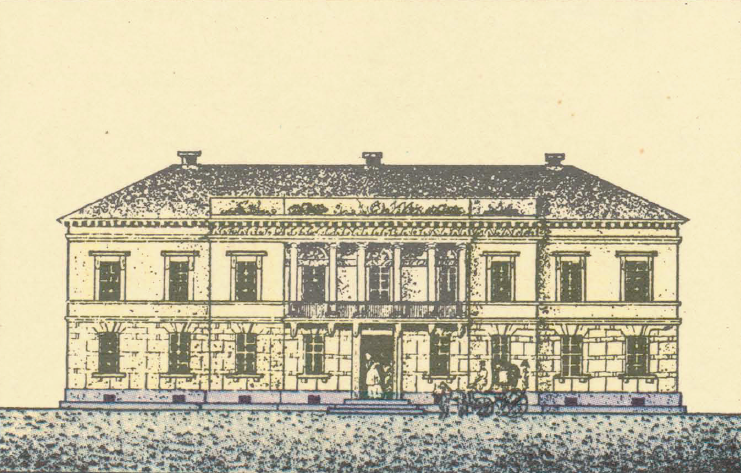Over night—under the blaze of a twelve o’clock sun—we had commissioned a man to find us carriers, and in the morning we crossed the river below that lonely Russian chapel, we and our goods, and in ten minutes the real troubles of the journey had fairly begun.
Never were such carriers. They were all able-bodied Finns, though one (and he was the strongest) had a hump like a Brahmin cow, another had a hare-lip, and the headman possessed a most virulent squint; but they were the most impracticable creatures that ever slouched over the face of the earth. Our luggage was not heavy; two negro carriers on the Congo or the Gold Coast would have capered with the whole lot of it; but through a wish for long quick marches, we had made it up into three light loads. There were two sacks, and a canvas-covered box containing a few tins, some cartridges, and four pounds of cake tobacco.
Now we both knew something about packs and loads in other parts of the world; but the Finn carrier was new to us, and his ways were strange; and it is always dangerous to introduce customs from a distance for consumption in a country whose difficulties you do not understand. So although we made suggestions, we did not insist on them, and the carriers muddled on with the preparations in their own way.
The neat, rectangular, canvas-covered box was eliminated first. We had looked upon it as an ideal “load”; in Africa there would have been a vigorous scramble for it; but the Finns said it was impossible to tackle anyhow. They scouted all suggestions of slinging, or carrying it hammock fashion, and fetched out another sack and made a re-stowal. Naturally the bundle so contrived was about as impossible to carry on human shoulders as a live porcupine would have been. So a blanket was taken out of one of the sacks and used as a pad. And next the sacks were objected to, and their contents split up, till finally our possessions were made into seven bundles of much fragility.
They worked hard over making this muddle; they took two mortal hours over it, and frequently called upon us for assistance; but finally they limbered up with the help of abundance of thongs of reindeer hide and rope, and we put backs to the river and set off on our march.
Tuoreempaa ja tutkitumpaa Lapista
- Helm, Britta: Were the Sámi Swedes?: Swedish scholarly ethnographic perspectives on the Sámi,1555 to 1848
- Stefan Hansson: Kulturkrock i lappmarken - Fyra fallstudier om mötet mellan samer och den svenska elitkulturen under tidigmodern tid
- Rosengren, Anna: Samiska kvinnor och osynlig historia: En komparativ studie av svenskar och samer vid 1600-talstinget
- Nordin, Gabriella: Äktenskap i Sápmi: Giftermålsmönster och etnisk komplexitet i kolonisationens tidevarv, 1722-1895
- Kumpulainen, Riitta: Timber And Herring: Modernisation And Mobility In Finnish Lapland And The Western Islands Of Scotland, 1770-1970
- Kaikkonen, Konsta: Personhood and religious change among the Saami: reviewing historical texts
- Myllyniemi, Heikki: Julistusta ja palvelua kirkossa, syrjäkylillä, metsäkämpillä, uitoissa, poroerotuksessa : Mauno Koivuneva Utajärven kirkkoherrana 1953-1971
- Ojala, Carl-Gösta: Sámi Prehistories: The Politics of Archaeology and Identity in Northernmost Europe
- Havela, Tanja: Kittilän lapinkylä: soveltava taide kulttuuriperinnön representaationa
- Kugapi, Outi: "Se on sydämen asia se saamenkäsityö": matkailun vaikutukset saamelaiseen käsityökulttuuriin ja kulttuuri-identiteettiin
- Ehn, Thérese: Samernas plats i det svenska kulturarvet: vem har rätt att representera vem?
- Juuso, Anni-Kristiina: Gii jáhkát don leat? Gii lea sápmelaš? : oikeudellisen saamelaismääritelmän vaikeudesta alkuperäiskansan olemassaoloon
- Andersson Hjulman, Tore: The Sámi became naturized in the wake of the territorial colonization
- Äikäs, Tiina: "Kelle se tieto kuuluu, ni sillä se on." : osallistava GIS Pohjois-Suomen pyhien paikkojen sijaintietoon liittyvien näkemysten kartoituksessa
- Seppänen, Raija: "Ikäns elä, ikäns opi, oppimatta kuole" : saamelaisten ikämiesten elämänhallinnan muistelukset Pohjois-Lapissa
Sekä erityisesti Tornionjokilaaksosta
Kuvat:
"Peter Parley's common school history. Illustrated by engravings" (1857). Internet Archive, Flickr Commons
'Das kleine Kind vom Tragbett bis zum ersten Schritt. Ueber das Legen, Tragen und Wiegen, Gehen, Stehen und Sitzen der kleinen Kinder bei den verschiedenen Völkern der Erde'. British Library, Flickr Commons
'Finland in the Nineteenth Century: by Finnish authors. Illustrated by Finnish artists. (Editor, L. Mechelin.)'. British Library, Flickr Commons
Alex Federleyn valokuva Torniosta n. 1900-1910. Åbo Akademis bibliotek, Flickr CC BY 2.0
- Arell, Nils: Rennomadismen i Torne lappmark: markanvändning under kolonisationsepoken i fr.a. Enontekis socken
- Sundquist, Maria: Äktenskap i gränsland: Relationer i Tornedalen 1780-1850
- Byström, Tony: Civiliseringsprocessen i Torneå Lappmark: En studie om civiliseringsprocessen ur ett perifert perspektiv
- Elenius, Lars: Både finsk och svensk : modernisering, nationalism och språkförändring i Tornedalen 1850-1939
- Tapio, Tarja: "Meilä on kaikila samanlaiset tarinat" : tarinankerrontatutkimus tornionlaaksolaisuudesta vanhimpien aapualaisten arjessa ja tulevaisuudessa
Kuvat:
"Peter Parley's common school history. Illustrated by engravings" (1857). Internet Archive, Flickr Commons
'Das kleine Kind vom Tragbett bis zum ersten Schritt. Ueber das Legen, Tragen und Wiegen, Gehen, Stehen und Sitzen der kleinen Kinder bei den verschiedenen Völkern der Erde'. British Library, Flickr Commons
'Finland in the Nineteenth Century: by Finnish authors. Illustrated by Finnish artists. (Editor, L. Mechelin.)'. British Library, Flickr Commons
Alex Federleyn valokuva Torniosta n. 1900-1910. Åbo Akademis bibliotek, Flickr CC BY 2.0




































